





1、 The results of laser particle size analyzer can show the average particle size (median diameter), boundary particle size and the dispersion of particle size distribution.
The average particle size indicates that 50% of the samples are smaller than it and 50% larger than it.
Boundary particle size: it is closer to the maximum and minimum particle size in popular sense. However, it is unscientific to use the maximum and minimum particle sizes to describe the upper and lower limits of sample particle size, so it is generally expressed by a pair of boundary particle sizes, such as (D10, D90) = (8, 60), which means that the number of particles smaller than 8 μ M accounts for 10% and that of particles less than 60 μ m accounts for 90%.
The dispersion of particle size distribution = (d90-d10) / D50. The smaller the dispersion is, the narrower the range of particle size distribution is. The smaller the number of oversized and smaller particles is, the more concentrated the particle size is.
2、 The relationship between particle size and powder quality is as follows
The particle size distribution is closely related to the coating texture, smoothness, gloss, particle, electrification effect, powder fluidization effect, storage stability and powder recovery rate.
1. Appearance, leveling and particle
Generally speaking, the smaller the powder particle size, the better the smoothness of the coating during curing; under the same spraying thickness, the powder with small particle size is less likely to appear particles; the smoother and smoother the appearance of the coating film is.
2. Charging effect and powder loading rate
The powder loading rate of powder coating will be increased by increasing the charging capacity of powder particles. The main adsorption force of electrostatic spraying is electrostatic force, and the powder loading rate mainly depends on the amount of charged powder particles. The charge of the powder is proportional to the square of the particle size. With the increase of particle size, the charge capacity of the powder increases and the powder loading rate increases. However, the particle size of powder particles should not be too large. The gravity of large particles of powder exceeds the aerodynamic force and electrostatic force. In the process of flying, the powder coating will fall down before reaching the surface of the workpiece due to gravity, which will reduce the powder loading rate. If the powder is too fine, the electrification will be reduced, and the coating efficiency will be reduced. The superfine powder (particle size < 10 μ m) is basically not charged. At the same time, too fine powder also increases the difficulty of powder production.
3. Fluidization effect of powder
When the powder is too fine, the fine powder will be agglomerated and will not disperse during fluidization. When sprayed on the workpiece, it will form a smooth package, which will affect the appearance of the coating. When the powder is too coarse, it is not easy to fluidize in the powder barrel.
4. Storage stability
Stability refers to the ability of powder coatings to maintain the size, shape and hardness of powder particles under certain conditions, that is, whether the powder will absorb moisture and agglomerate during storage or use. Generally, the finer the powder is, especially the content of superfine powder below 10 μ m is too much, the powder is easy to absorb moisture and agglomerate, and the stability will be reduced. When using, the spray gun will be blocked and the powder will be poor.
5. Recovery rate
Powder coating factories and powder coating plants have the problem of recycling powder coatings. Generally, the recovery rate of superfine powder with particle size less than 10 μ m is low. When the particle size of powder is more than 10 μ m, the recovery rate of powder coating increases rapidly, and the recovery rate of powder increases with the increase of particle size.

Online
consultation